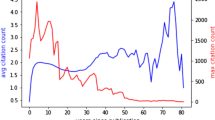Abstract
Seven attributes that I think distinguish exemplary from other manuscripts that use quantitative research methods are discussed in this article. The attributes have evolved in unknown ways as a result of my experiences as a doctoral student, contributor to the literature, and service as an editor of scholarly publications. My hope is that the suggestions provided herein will be of use to graduate students and junior scholars as they prepare manuscripts for publication consideration.
Similar content being viewed by others
References
InstitutionalAuthorNameAmerican Psychological Association (2001) Publication manual of the American Psychological Association EditionNumber5 Author Washington, DC
A. W. Astin (1984) ArticleTitleStudent involvement: A developmental theory for higher education Journal of College Student Personnel 25 297–308
J. P. Bieber (1999) Cultural capital as an interpretive framework for faculty life J. C. Smart (Eds) Higher Education: Handbook of Theory and Research Agathon Press New York 367–397
J. M. Braxton (Eds) (2000) Reworking the Student Departure Puzzle Vanderbilt University Press NashvilleTN
J. M. Braxton A. V. S. Sullivan R. M. Johnson (1997) Appraising Tinto’s theory of college student departure J. C. Smart (Eds) Higher Education: Handbook of Theory and ResearchVol. 14 Agathon Press New York 107–164
K. S. Cameron (1986) ArticleTitleA study of organizational effectiveness and its predictors Management Science 32 87–112
K. S. Cameron D. R. Ettington (1988) The conceptual foundations of organizational culture J. C. Smart (Eds) Higher Education: Handbook of Theory and Research Agathon Press New York 356–396
K. S. Cameron D. Whetten (1996) Organizational effectiveness and quality: The second generation J.C. Smart (Eds) Higher Education: Handbook of Theory and Research Agathon Press New York 265–306
C. A. Ethington (1997) A hierarchical linear modeling approach to studying college effects J. C. Smart (Eds) Higher Education: Handbook of Theory and Research Agathon Press New York 165–194
C. A. Ethington T. B. Polizzi (1996) ArticleTitleAn assessment of the construct validity of the CCSEQ quality of effort scales Research in Higher Education 37 711–730
C. A. Ethington S. L. Thomas G. R. Pike (2002) Back to the basics: Regression as it should be J.C. Smart (Eds) Higher Education: Handbook of Theory and Research Kluwer Academic Publishers DordrechtThe Netherlands 263–293
R. A. Fisher (1925) Statistical Methods for Research Workers Oliver & Boyd London
J. Friedlander C. R. Pace P. W. Lehman (1990) Community College Student Experiences Questionnaire University of California Center for the Study of Evaluation Los Angeles
K. Joreskog D. Sorbom (1984) LISREL VI: Analysis of Linear Structural Relationships by Maximum LikelihoodInstrumental Variables, and Least Squares Methods Scientific SoftwareInc MooresvilleIN
T. L. Kelley (1935) ArticleTitleAn unbiased correlation ratio measure Proceedings of the National Academy of Sciences 21 554–559
F. Kerlinger (1986) Foundations of Behavioral Research (3rd Ed.) Holt Rinehart & Winston New York
R. E. Kirk (1996) ArticleTitlePractical significance: A concept whose time has come Educational and Psychological Measurement 56 746–759
R. J. Light J. D. Singer J. B. Willett (1990) By Design: Planning Research on Higher Education Harvard University Press Cambridge MA
S. Olejnik J. Algina (2000) ArticleTitleMeasures of effect size for comparative studies: Applications, interpretations, and limitations Contemporary Educational Psychology 25 241–286
C. R. Pace (1979) Measuring Outcomes of College: Fifty Years of Findings and Recommendations for the Future Jossey-Bass Publishers San Francisco
C. R. Pace (1987) CSEQ: Test Manual and Norms: College Student Experiences Questionnaire University of California Center for the Study of Evaluation Los Angeles
E. T. Pascarella P. T. Terenzini (1980) ArticleTitlePredicting freshman persistence and voluntary dropout decisions from a theoretical model Journal of Higher Education 51 60–75
E. J. Pedhazur (1982) Multiple Regression in Behavioral Research: Explanation and Prediction HoltRinehart & Winston New York
P. Snyder S. Lawson (1993) ArticleTitleEvaluating results using corrected and uncorrected effect size estimates Journal of Experimental Education 61 334–349
P. T. Terenzini (1993) ArticleTitleOn the nature of institutional research and the knowledge and skills it requires Research in Higher Education 34 1–10
B. Thompson (2002) ArticleTitleStatistical, practical, and clinical: How many kinds of significance do counselors need to consider? Journal of Counseling and Development 80 64–71
V. Tinto (1975) ArticleTitleDropout from higher education: A theoretical synthesis of recent research Review of Educational Research 45 89–125
V. Tinto (1993) Leaving College: Rethinking the Causes and Cures of Student Attrition (2nd Ed.) University of Chicago Press Chicago
W. B. Walsh (1973) Theories of Person-environment Interaction: Implications for the College Student American College Testing Program Iowa City
L. Wilkinson InstitutionalAuthorNameAPA Task Force on Statistical Inference (1999) ArticleTitleStatistical methods in psychology journals: Guidelines and explanations American Psychologist 54 594–604
Author information
Authors and Affiliations
Corresponding author
Rights and permissions
About this article
Cite this article
Smart, J.C. Attributes of Exemplary Research Manuscripts Employing Quantitative Analyses. Res High Educ 46, 461–477 (2005). https://doi.org/10.1007/s11162-005-2970-5
Received:
Issue Date:
DOI: https://doi.org/10.1007/s11162-005-2970-5




